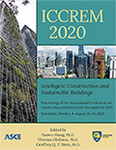International Conference on Construction and Real Estate Management 2020
Public Art, Public Sphere, and Urban Development in the Chinese Metropolis
Publication: ICCREM 2020: Intelligent Construction and Sustainable Buildings
ABSTRACT
Alongside the rapid urban development and continuous infrastructure improvements that accompany the urban transformation of contemporary China, the challenges of defining and shaping a distinctive image for a city has attracted considerable interest from many urban planners, property developers, and city administrations. Among the wide range of urban development strategies employed to promote and enhance urbanization, the deployment of artworks in urban space (“public art”) is increasingly visible and widespread. This paper aims to analyse the relationship between public art and urban development in the metropolitan contexts of Beijing and Shanghai, seeking to identify the circumstances that accompany the implementation of public art in mainland Chinese cities. Selected case studies in the business centres of the political capital of Beijing and the economic centre of Shanghai are analysed and used to discuss how strategies of urban development intersect with the implementation of public art projects. The findings reveal a number of ways in which this nexus is configured, and suggest several categories useful for the study of public art in China. The paper aims to contribute to an ongoing discussion of the complexities that attend the implementation of public art within the rapidly transforming Chinese metropolis, and ultimately improve the understanding of the distinctive trajectory of China’s urban development.
Get full access to this article
View all available purchase options and get full access to this chapter.
ACKNOWLEDGEMENTS
The project is part of doctoral research being conducted at the Centre for Asian and Middle Eastern Architecture (CAMEA) at the University of Adelaide, and the authors acknowledge the contribution of several artists and planners in China who have shared their experiences through a series of interviews conducted over the last two years.
The authors declare no conflicts of interest.
REFERENCES
Bishop, C. (2012). Artificial Hells: Participatory Art and the Politics of Spectatorship. Verso Books, London, 129.
Bickel, B., Triggs V., Springgay S., Irwin R., Grauer K., Xiong G., Beer R. and Sameshima P. (2007). “Richgate: Transforming Public Spaces through Community-Engaged Art.” Amerasia Journal,33(2), 115-24.
Chaffee, L. (1988). “Social conflict and alternative mass communications: public art and politics in the service of Spanish-Basque nationalism.” European Journal of Political Research, 16(5), 545-72.
Congress, U. S. (2014). “National Foundation on the Arts and the Humanities Act of 1965.” Public Law, 209.
Hsing, Y.T. (2010). The Great Urban Transformation: Politics of Land and Property in China. Oxford University Press, Oxford.
Hao, H. (2014). “To integrate art into urban life: the quality of public art is the soft power of urban culture.” People’s Daily., Oct. 31. (in Chinese).
Hood, C. (2000). The art of the state: Culture, rhetoric, and public management. Oxford University Press, UK.
Markusen, A., and Gadwa, A. (2010). “Arts and Culture in Urban or Regional Planning: A Review and Research Agenda.” Journal of Planning Education and Research, 29(3), 379-91.
Urban Task Force. (2003). Towards an Urban Renaissance. Routledge, London.
Wu, D.Y. (2015). “Integration and Evolution: The Development of Chinese Public Art.” Zhuang Shi: Chinese Journal of Design, 271(11), 38-45. (in Chinese).
Yi, Y. (2004). “Public art and publicness.” Literature and Art Studies, (05), 121-126+161. (in Chinese).
Zebracki, M. (2011). “Does cultural policy matter in public art production? The Netherlands and Flanders compared, 1945-present”. Environment and Planning A, 43, 2953-70.
Zhou, L. (2012). “The bottleneck phenomenon in the development of contemporary urban public art.” Grand Stage, 8, 293-294. (in Chinese).
Zheng, J. (2017). “Contextualizing public art production in China: The urban sculpture planning system in Shanghai.” Geoforum, 82, 91. (in Chinese).
Information & Authors
Information
Published In
ICCREM 2020: Intelligent Construction and Sustainable Buildings
Pages: 206 - 215
Editors: Yaowu Wang, Ph.D., Harbin Institute of Technology, Thomas Olofsson, Ph.D., Luleå University of Technology, and Geoffrey Q. P. Shen, Ph.D., Hong Kong Polytechnic University
ISBN (Online): 978-0-7844-8323-7
Copyright
© 2020 American Society of Civil Engineers.
History
Published online: Oct 14, 2020
Authors
Metrics & Citations
Metrics
Citations
Download citation
If you have the appropriate software installed, you can download article citation data to the citation manager of your choice. Simply select your manager software from the list below and click Download.
